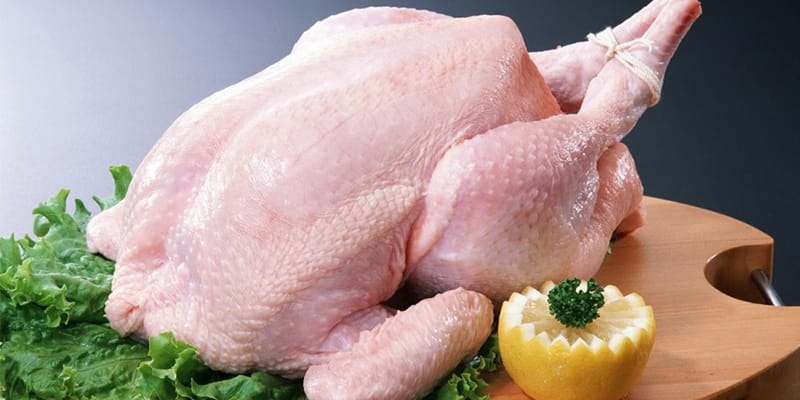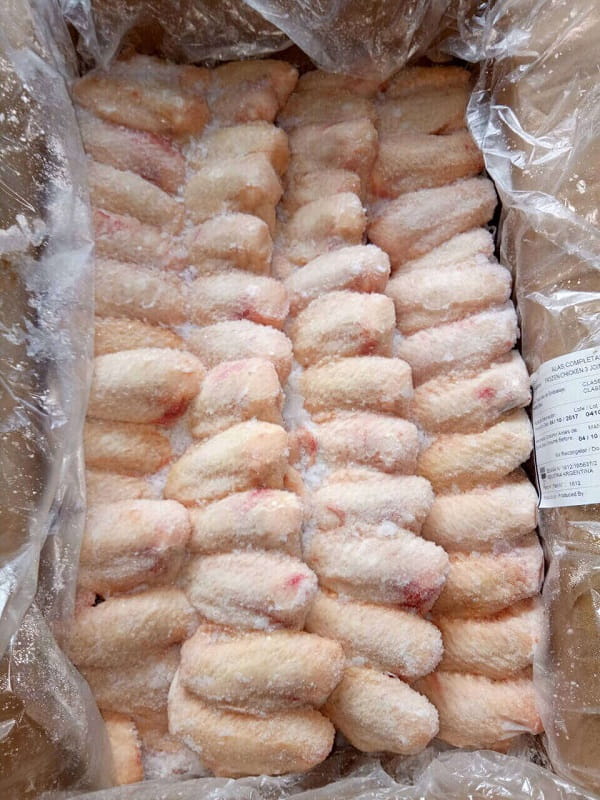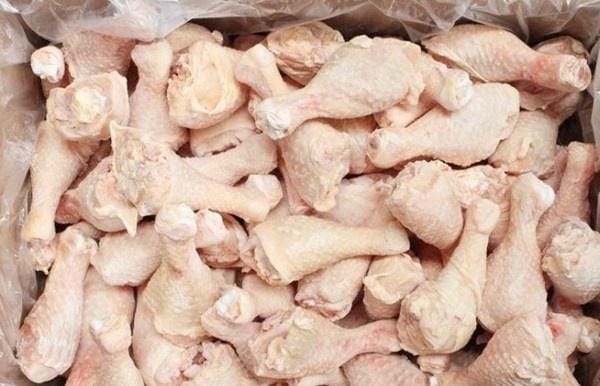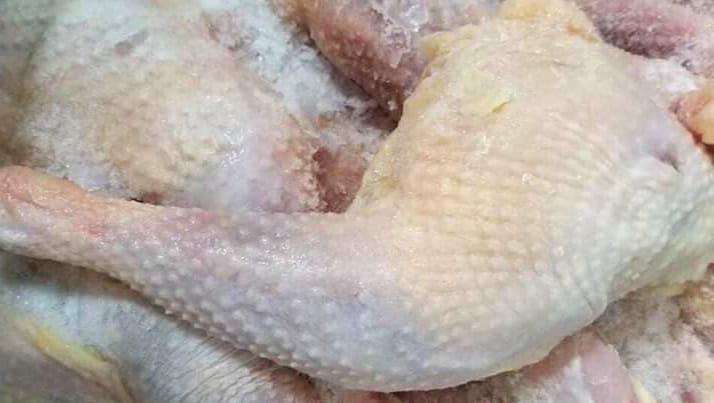When it comes to food safety, knowing how long certain items can sit out at room temperature is crucial. Many ask how long frozen chicken can sit out before it becomes unsafe to eat. While it might seem like frozen chicken is immune to the same rules as fresh meat, that’s not the case. Depending on factors like ambient temperature and humidity level, frozen chicken can only sit out for a certain duration before it becomes a health hazard. This article will explore how long can frozen chicken sit out, what factors impact this timeline, and what steps you can take to ensure your chicken stays safe.
Introduction to Frozen Chicken Storage and Safety

Welcome, reader! Are you looking for ways to store and safely handle frozen chicken? If so, you’ve come to the right place. This blog post will provide you with an introduction to frozen chicken storage and safety.
Frozen chicken is a popular choice for many households and can be a great way to save money and ensure that you’ll have enough food on hand. It’s important to remember that frozen chicken is perishable and must be stored and handled properly to remain safe and nutritious.
When storing frozen chicken, there are a few key points to remember. First, ensure the chicken is stored in the coldest part of your refrigerator. This will help ensure the chicken maintains a safe temperature and does not spoil. Second, make sure that the chicken is wrapped securely in airtight packaging. This will help to prevent freezer burn and will also help to keep the chicken from absorbing odors from other foods.
There are also some important safety tips to remember when handling frozen chicken. First, make sure that you thoroughly thaw the chicken before cooking it. This will help to reduce the risk of bacterial contamination. Second, ensure you cook the frozen chicken all the way through. This will help to ensure that any bacteria that may have been present on the chicken is killed. Finally, ensure you properly reheat any cooked chicken to an internal temperature of 165 degrees Fahrenheit.
Is It OK To Leave Frozen Chicken Out Overnight?
As per the USDA guidelines, frozen food should always be stored at a temperature of 0°F or lower to prevent harmful bacteria from growing. This applies to any meat product, whether raw, cooked, or frozen. Leaving meat out at room temperature can make it a breeding ground for bacteria that can cause food poisoning. Moreover, thawing meat at room temperature or in hot water can cause the meat to enter the food danger zone of 40°F.
Therefore, it is always best to thaw frozen chicken in the fridge where the temperature is regulated or use the following safe methods to thaw the chicken. It is better to be safe than sorry when it comes to food safety, and nobody wants to risk getting sick from improperly handled food.
How Long Can Frozen Chicken Sit Out?
According to food safety guidelines, the frozen chicken should not be left out for too long at room temperature. While it can safely sit at room temperature for up to two hours, it’s best practice to thaw and cook the chicken. Leaving frozen chicken out overnight at room temperature is not recommended. Never thawing frozen chicken at room temperature or hot water is important, as that can cause bacterial growth.
However, raw chicken cutlets can stay frozen for up to nine months. Cooked leftovers don’t stay this long in the freezer, either. In summary, it’s best to practice safe food handling habits to ensure the quality and safety of frozen chicken.
How Long Can Thaw Chicken Sit Out Before it Goes Bad?

According to the United States Department of Agriculture, thawed chicken can sit at room temperature for up to two hours. After that, stowing it away in the refrigerator or freezer is essential to prevent bacteria from growing and making the chicken unsafe to eat.
It’s important to note that this two-hour window applies to both raw and cooked chicken. If the room temperature is above 90°F, the time limit drops to just one hour. To ensure maximum safety and freshness, it’s always best to thaw and cook the chicken as soon as possible.
What Is The Ideal Temperature For Storing And Thawing Chicken?
There are a few key things to remember when storing and thawing chicken. First, the ideal temperature for storing chicken is in the refrigerator at 40°F. It’s important to regularly check the temperature with a thermometer to ensure that it stays within this range. The best and safest method for thawing chicken is in the fridge, but this requires some planning as it can take around a day.
It’s important to avoid thawing chicken at room temperature as this puts it in the “danger zone” for bacteria growth. Additionally, it to avoid keeping raw chicken at a temperature above 40°F, as this can lead to condensation and increase the risk of bacterial growth.
Read more:
Factors that Affect Frozen Chicken Shelf Life
Understanding the factors affecting frozen chicken shelf life can help ensure you always have fresh and safe chicken to use in your recipes.
The most important factor in determining the shelf life of a frozen chicken is the temperature of your freezer. The ideal temperature for your freezer should be 0°F or lower. This will help keep frozen chicken at its highest quality for as long as possible. Any higher and the chicken will begin to lose flavor and texture.
In addition to temperature, the time the chicken has been in the freezer will also affect its shelf life. The longer it’s been stored in the freezer, the more quality it will lose. This is why keeping track of when the chicken was purchased and when it’s time to throw it out is important.
The packaging of the frozen chicken can also affect its shelf life. If the packaging is torn or damaged, air can get inside and cause the chicken to spoil more quickly. Check the packaging when buying frozen chicken to ensure it’s not damaged.
Finally, certain bacteria and microorganisms can affect the shelf life of a frozen chicken. The bacteria and microorganisms can grow and spread quickly, causing the chicken to spoil more quickly than it would otherwise. Keep your chicken wrapped tightly and in an airtight container to avoid this.
Does Frozen Chicken Need To Be Refrigerated?
The short answer is yes, frozen chicken must be refrigerated to remain safe and edible. This is true regardless of the type of chicken that you’re dealing with (fresh or frozen). The longer answer to the question comes with a few important considerations.
First, it’s important to understand the difference between the fresh and frozen chicken. Fresh chicken is usually kept at temperatures unsafe for human consumption, such as in the freezer for extended periods. On the other hand, frozen chicken is generally kept at temperatures safe for human consumption, such as between 0 and -4 degrees Fahrenheit.
Any chicken that has been frozen needs to be stored in a refrigerator or other cold storage facility to remain safe to consume. Once the chicken has been thawed, it should be eaten within two days or stored in the refrigerator for up to four days. It should be thrown away if it hasn’t been eaten within these two days. Additionally, it’s important to avoid refreezing chicken that has been thawed.
It’s also important to note that any chicken should be cooked thoroughly to ensure it is safe to consume. This means it should be cooked to an internal temperature of at least 165 degrees Fahrenheit.
Can Frozen Chicken Be Refrozen After It Has Been Thawed?

The answer is yes. However, it’s important to take the necessary precautions to ensure the quality and safety of the chicken.
First and foremost, it’s important to note that the quality of the chicken will suffer the more times it is frozen and thawed. The more times the chicken is frozen, the more likely it is to develop freezer burn. This will result in a dry, mealy texture and off-flavors that won’t be appetizing. Therefore, limiting the number of times your frozen chicken is refrozen is best.
If you need to refreeze your thawed chicken, there are a few precautions you should take. It’s essential to ensure the chicken is completely defrosted before refreezing. If it’s not, ice crystals may form in the chicken, leading to a nasty texture.
Once the chicken is completely thawed, you should also make sure to cook it thoroughly before refreezing it. All bacteria, including salmonella, should be killed off by heating the chicken to 165°F. This will ensure the chicken is safe when you eventually thaw it again.
Finally, keep the thawed chicken as cold as possible before refreezing it. This means storing it in the refrigerator until you can put it in the freezer. Keeping it cold will reduce the chances of bacteria growth while it’s in the fridge.
Can Bacteria On Chicken Be Killed By Cooking It Thoroughly, Or Should It Be Thrown Away If It Has Been Left Out Too Long?
Did you know cooking chicken and turkey at 165°F is the best way to kill harmful bacteria like Campylobacter and Salmonella? Thorough cooking is key, as it can generally destroy most bacteria in raw meat, including pathogenic ones. Eating can be safe if the meat has been handled correctly before cooking and hasn’t been left at room temperature for too long.
However, it’s important always to use a food thermometer to check that the meat is cooked through. On the other hand, if the meat has been left out for too long, it’s best to err on the side of caution and throw it away. It’s always better to be safe than sorry regarding the potentially deadly consequences of food poisoning. Remember, improper food handling can sicken or even kill, so it’s essential to follow safety guidelines and take every precaution to keep yourself and your loved ones healthy.
Is it Better to Freeze Cooked or Raw Chicken?
To answer this question, it is important to understand the differences between frozen cooked and raw chicken and the potential risks associated with each.
Freezing cooked chicken is the preferred method for many home cooks. This is because cooked chicken can be kept in the freezer for up to four months without losing quality. Freezing cooked chicken also allows you to enjoy leftovers, as cooked chicken is already cooked and ready to eat. Store it in an airtight container and the coldest part of your freezer when freezing cooked chicken.
On the other hand, freezing raw chicken can also yield good results if done correctly. It should be noted, however, that raw chicken should only be frozen for up to two months. For best results, it is important to wrap the raw chicken tightly in plastic wrap and place it in an airtight container before freezing. This way, you can prevent freezer burn and ensure the chicken is safe to consume when thawed.
Regardless of your chosen method, it is important to remember that freezing chicken can reduce its nutritional value. This is because some of the vitamins and minerals can be lost during the freezing process. In addition, freezing can cause changes to the texture and flavor of the chicken, so it may not taste the same when thawed.
Overall, it is up to you to decide which method of freezing chicken is best for your needs. If you want convenience, freezing cooked chicken is probably the way. However, if you want the most nutritional benefit, freezing raw chicken is the way to go.
How to Tell if Frozen Chicken Has Gone Bad?
It can be difficult to say, as with any food stored for a long time. But, if you know what signs to look for, you can quickly determine whether or not that frozen chicken has gone bad.
- The first thing to look for is the color and smell of the chicken. If it looks and smells suspicious, then it’s likely gone bad. If the chicken looks grey or smells strange, it’s probably time to throw it out.
- The next thing to check is the packaging. If the packaging is no longer sealed, or if there is any discoloration or bulging of the packaging, then it’s likely that the chicken has gone wrong. Frozen chicken should always be stored in a tightly sealed package and never left out of the freezer for too long.
- Another way to tell if the chicken is no longer good is to feel the texture. If the chicken feels slimy or has a slime-like texture, it’s likely gone bad and should be thrown out.
- Finally, if you have any doubts, you can always thaw the chicken and check it more closely. If you thaw the chicken and it still looks or smells strange, then it’s time to throw it out.
Tips to Avoid Buying Rotten Chicken

Rotten Chicken can be dangerous to your health. So, to avoid such a situation, knowing what to look out for when buying chicken is essential. Here are some tips to help you avoid buying rotten chicken:
- Check the “sell-by” date: The sell-by date on the package is an excellent indicator of when the chicken was processed. If the date has passed, the chicken may be expired or spoiled.
- Smell the chicken: Chicken that has gone bad has a distinctively unpleasant odor. If the chicken has a strong smell, it is best to avoid it.
- Look for discoloration: Spoiled chicken often has a green or yellowish tinge. Additionally, it may have a slimy or sticky surface. If you notice any of these signs, avoid buying the chicken.
- Check the package: If the packaging is damaged or torn, the chicken has likely been exposed to bacteria or other contaminants.
- Buy from a reputable store: Buying your chicken from a reputable store is an excellent way to ensure you get fresh chicken.
Tips for Reheating Frozen Chicken Safely
Reheating frozen chicken can be tricky, and if done incorrectly, it can lead to food poisoning or other food-related illnesses. To help ensure that your frozen chicken is reheated safely, follow these tips:
- Thaw the chicken properly. Before reheating your frozen chicken, it’s important to thaw it properly. The best way to do this is to move the chicken from the freezer to the refrigerator and let it sit for several hours to thaw. This will help to ensure that it is safe to eat.
- Use the correct method. Once the chicken is thawed, you will want to use the correct method to reheat it. It’s essential to use a microwave-safe container and stir the chicken frequently to ensure it is cooked evenly. Reheating chicken in the oven is also an option, but make sure to use a low temperature and to check for doneness often.
- Reheat to the right temperature. The most important part of reheating frozen chicken is to ensure it is thoroughly heated to 165 degrees Fahrenheit. Use a food thermometer to ensure the chicken is heated through.
- Enjoy! Now that your frozen chicken is reheated correctly, you can enjoy it. Be sure to serve it immediately after reheating to ensure it stays at a safe temperature.
How to Properly Freeze and Store Chicken
Freezing and storing chicken correctly will help ensure it stays fresh and flavorful for up to three months. Freezing chicken before it expires will also help you save time and money in the long run.
The first step in freezing and storing chicken is to package it properly. Make sure you’re using air-tight plastic storage bags or freezer-safe containers. If you’re freezing a full chicken or larger pieces, it’s best to separate the pieces so they can freeze faster. For smaller pieces, such as chicken breasts and wings, it’s best to freeze them in a single layer.
Once the chicken is adequately packaged, label it with the date and type of chicken before putting it in the freezer. This will help you track when the chicken was frozen so you can use it before it goes bad.
When it’s time to thaw the chicken, do it in the refrigerator to ensure it stays fresh. If you try to thaw it at room temperature, bacteria can grow quickly and cause food poisoning.
Cool it to room temperature when storing cooked chicken before refrigerating or freezing it. Once refrigerated, cooked chicken should be used within four days. If you’re freezing it, use it within one month.
How to Thaw Frozen Chicken Safely

There are safe, easy ways to thaw frozen chicken so you can still save dinner.
Remembering that chicken should never be thawed at room temperature is important. This can lead to bacterial growth that can make you sick. To thaw chicken safely, you should plan and start to thaw it in the refrigerator. If you don’t have time for this method, there are two more rapid ways to thaw frozen chicken.
- The first is to submerge the chicken in cold water. Place the chicken in a leak-proof bag, seal it tightly, and submerge it in cold water. Change out the water every 30 minutes until the chicken is completely thawed. Make sure to cook the chicken immediately after it’s thawed.
- The other option is to use your microwave. When using the microwave to thaw chicken, cooking it immediately after thawing is important. This is because some chicken areas can become warm, and bacteria can grow. To thaw the chicken in the microwave, place the chicken in a microwave-safe dish and follow the directions on your microwave.
Common Mistakes to Avoid When Storing Frozen Chicken
Storing frozen chicken correctly ensures its freshness, flavor, and safety. Unfortunately, many people make common mistakes when storing frozen chicken, leading to spoilage and potential health risks. To help you avoid these mistakes, here are the top 7 common mistakes to avoid when storing frozen chicken.
- Not Checking the Expiration Date: Always check the expiration date on your frozen chicken before storing it. Frozen chicken should be consumed within 1-2 months of purchase, so check the date before placing it in the freezer.
- Not Labeling It: Labeling your frozen chicken with the date and type of chicken is essential. This will help you avoid confusion when you eat it and ensure you consume the freshest product possible.
- Not Separating the Chicken: Make sure to separate the chicken into individual pieces or packages before freezing. This will help you avoid cross-contamination and ensure that each piece is appropriately cooked before consumption.
- Not Keeping It at the Right Temperature: It’s important to store frozen chicken at 0°F (-18°C) or lower. Any higher than this, and it could start to spoil. If you’re unsure what temperature your freezer is set at, try using a refrigerator thermometer to check.
- Not Wrapping It Properly: Make sure to wrap your chicken in airtight packagings, such as plastic wrap or foil, before freezing. This will help prevent freezer burn and ensure that your chicken stays fresh.
- Not Defrosting Properly: Never defrost chicken at room temperature. Instead, defrost it in the refrigerator or microwave. If you’re defrosting in the microwave, always cook it immediately after defrosting.
- Not Storing It Properly: Always store your frozen chicken in an appropriate container. You can store it in a plastic bag, airtight container, or freezer-safe bag. This will help keep the chicken fresh and free from any potential contamination.
Symptoms of Food Poisoning from Eating Spoiled Chicken
Food poisoning from eating spoiled chicken can be an unpleasant and even dangerous experience. Symptoms of food poisoning from eating spoiled chicken can range from mild to severe depending on the type and amount of bacteria present in the contaminated food. Common symptoms of food poisoning from spoiled chicken include nausea, vomiting, abdominal cramps, diarrhea, and fever. In severe cases, food poisoning can lead to dehydration and even death.
When it comes to food poisoning from eating spoiled chicken, the most common type of bacteria causing the illness is Salmonella. This bacteria is found in poultry and other animals and can cause foodborne illnesses when ingested. Other types of food poisoning that can result from eating spoiled chicken include E. coli, Campylobacter, Listeria, and Clostridium perfringens.
If you believe you are experiencing symptoms of food poisoning after eating spoiled chicken, it’s essential to seek medical attention immediately. It’s also important to dispose of the contaminated food properly and to practice proper food safety to prevent food poisoning from occurring in the future.
First Aid Tips for Food Poisoning from Chicken
It’s important to remember that food poisoning from chicken can be both dangerous and uncomfortable, so it’s important to pay attention to your symptoms, seeks medical attention if necessary, and take the proper steps to prevent further harm.
- The first step to dealing with food poisoning from chicken is to identify the source of the contamination. This could be from an improperly cooked piece of chicken, cross-contamination from other items in the refrigerator, or even from a restaurant or store. Once you’ve identified the source, properly clean and store all food items to prevent future contamination.
- If you’re experiencing symptoms of food poisoning, such as nausea, vomiting, diarrhea, abdominal cramping, and fever, it’s important to seek medical attention immediately. This is especially important if the symptoms become severe or if you experience any signs of dehydration.
- Once you’ve been diagnosed with food poisoning from chicken, it’s important to take the proper steps to prevent further harm. This includes drinking plenty of fluids, avoiding alcohol and caffeine, and getting plenty of rest. Additionally, taking anti-nausea medication and antibiotics prescribed by a doctor can be helpful.
- In addition to medical treatment, some simple first-aid tips can help you manage the effects of food poisoning. These include drinking clear liquids like water, broth, or sports drinks, eating light, bland meals, and avoiding greasy and spicy foods.
- Finally, taking the necessary steps to prevent future chicken food poisoning is essential. This includes washing your hands thoroughly with soap and water after handling raw chicken, covering food containers and refrigerating leftovers promptly, and avoiding cross-contamination of food items. Taking the proper steps can reduce your risk of food poisoning and ensure your safety.
Frozen Chicken Recipes for Quick and Easy Weeknight Meals

Whether you’re searching for something savory, spicy, or simple, we have the perfect frozen chicken recipes. Here are some of our favorite recipes to make your weeknight meals a breeze!
- Chicken Pot Pie: Who doesn’t love a classic chicken pot pie? This comforting dish is an all-time favorite, even better when using frozen chicken. Combine cooked frozen chicken, veggies, gravy, and a pie crust. Bake it in the oven and enjoy!
- Crispy Baked Chicken Tenders: This dish is perfect for kids and picky eaters. Start by coating frozen chicken tenders in a mixture of breadcrumbs and spices. Bake them in the oven and serve them with your favorite dipping sauces. It’s an easy, delicious way to get protein on the table.
- Buffalo Chicken Mac and Cheese: This dish is for you if you want something heartier. Make a creamy mac and cheese and top it off with a layer of cooked frozen chicken tossed in buffalo sauce. Bake in the oven and enjoy!
- Chicken Tikka Masala: This is a great way to bring an international flavor to your weeknight meals. Start by marinating frozen chicken in a mixture of spices and yogurt. Then, combine cooked chicken with a can of tomatoes, garlic, ginger, cream, and spices. Simmer and serve with white rice or naan bread.
FAQs About How Long Can Frozen Chicken Sit Out
Is it Safe to Eat Frozen Chicken Past the Expiration Date?
According to factual data, freezing greatly slows down the growth of bacteria that can cause spoilage. Hence, eating frozen chicken past the expiration date is safe from a food safety perspective. However, it may not taste good due to the loss of flavor and texture over time.
To prevent freezer burn, wrapping the chicken tightly and removing as much air as possible is important. In addition, checking the date on the package before consuming frozen chicken is a wise move. If the chicken has gone bad, throwing it away for safety is best.
Can You Thaw And Cook Frozen Chicken That’s Been Left Out, Or Should You Discard It?

It is safe to eat frozen chicken past its expiration date as long as it was fresh when it was frozen and has been continuously frozen. Freezing the chicken greatly slows the growth of bacteria that would otherwise cause the meat to spoil. The USDA notes that frozen chicken can be “safe indefinitely” if it remains frozen.
Although the expiration date on food helps estimate the timeframe for its highest quality, it is not necessarily an indication of safety. Properly stored, frozen chicken can maintain its quality for up to 9 months in the freezer. However, it is essential to check the date on the package; eating is unsafe if it has passed its expiration date.
How Long Does It Take For Bacteria To Grow On Chicken That Has Been Left Out?
According to the FDA, perishable foods should never be left at room temperature for more than two hours, and if the temperature is above 90°F, they should be discarded after just one hour. Bacteria grow most rapidly between 40–140°F, and in temperatures within this range, they can double in number in as little as 20 minutes. It’s essential to refrigerate poultry promptly to prevent bacterial growth and reduce the risk of foodborne illness. Remember, two hours is the maximum time perishable foods should be left out, so always refrigerate them within that time frame.
Conclusion
In conclusion, it is essential to handle frozen chicken properly to prevent foodborne illnesses. How long frozen chicken can sit out depends on various factors, such as the temperature, the packaging, and the time it has been defrosted. Generally, it is recommended to thaw frozen chicken in the refrigerator or microwave and cook it immediately.
If you must leave it out, ensure it is not in the danger zone for more than two hours. Following these guidelines lets you enjoy delicious and safe chicken dishes without compromising your health.
References:
- https://doh.wa.gov/you-and-your-family/food-safety/food-safety-myths
- https://www.foodnetwork.com/how-to/packages/help-around-the-kitchen/defrosting-chicken
- https://cooking.stackexchange.com/questions/55047/why-is-expired-frozen-chicken-safe-to-eat

Hey readers! Chip Holland here, and I’m a Manager of this website. My passion for writing about it only matches my passion for BBQ. Follow my blog for mouth-watering recipes, tips, and tricks for the perfect smoke, grill, and BBQ. I’m sure you won’t be disappointed!
